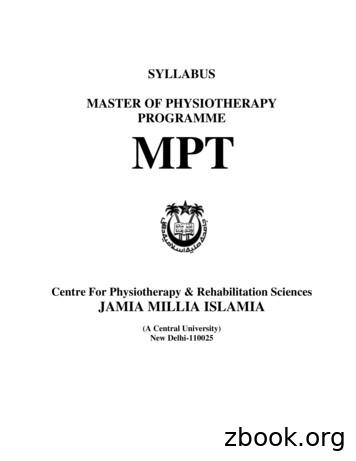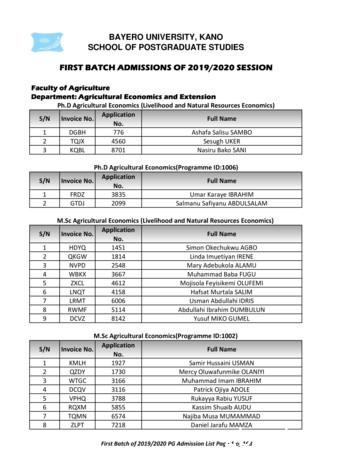Physiotherapy Management For COVID-19 In The Acute .
Physiotherapy Management forCOVID-19 in the Acute HospitalSetting:Recommendations to guide clinical practiceVersion 1.023 March 2020Open f-physiotherapyEndorsed by:
TITLE:Physiotherapy management for COVID-19 in the acutehospital setting: Recommendations to guide clinical practiceDESCRIPTION ANDOBJECTIVES:This document outlines recommendations for physiotherapymanagement for COVID-19 in the acute hospital setting. Itincludes recommendations for physiotherapy workforce planningand preparation, a screening tool for determining requirement ofphysiotherapy, recommendations for the selection ofphysiotherapy treatments and personal protective equipment.TARGET AUDIENCE:Physiotherapists and other relevant stakeholders in the acutecare setting caring for adult patients with suspected and/orconfirmed COVID-19VERSION NUMBER:1.0PUBLISHED DATE:23 March 2020AUTHORS:Peter ThomasClaire BaldwinBernie BissettIanthe BodenRik GosselinkCatherine L. GrangerCarol HodgsonAlice YM JonesMichelle E KhoRachael MosesGeorge NtoumenopoulosSelina M. ParryShane PatmanLisa van der LeeTRANSLATIONS:In progress (Portuguese, Spanish, French, Dutch, Greek,Chinese)Physiotherapy management for COVID-19. Version 1.0, 23/3/2020.Page 1
Disclaimer and CopyrightAn international team of expert researchers and clinicians within the intensive care andacute cardiorespiratory fields have developed these recommendations. Therecommendations are intended for use in adults only. This document has been constructedusing existing medical guidelines, relevant literature and expert opinion. The authors havemade considerable effort to ensure the information contained with the recommendation isaccurate at time of publication. Further iterations of these guidelines will be published asnew information arises. The information provided in this document is not designed to replacelocal institutional policies and should not replace clinical reasoning for individual patientmanagement. The authors are not liable for the accuracy, information that may be perceivedas misleading, or completeness of information in this document. The guideline group willreview and update this guidance within 6-months, or if important new evidence emerges thatchanges the recommendations herein.This work is copyright. It may be reproduced in whole or part for study or training purposessubject to the inclusion of an acknowledgement of the source. It may not be reproduced forcommercial usage or sale. Reproduction for purposes other than those indicated aboverequires written permission from Dr Peter Thomas via email:PeterJ.Thomas@health.qld.gov.auCitation of this workWe request that you attribute this publication and any material sourced from it using thefollowing citation: Thomas P, Baldwin C, Bissett B, Boden I, Gosselink R, Granger CL,Hodgson CL, Jones AYM, Kho ME, Moses R, Ntoumenopoulos G, Parry SM, Patman S,van der Lee L (2020): Physiotherapy management for COVID-19 in the acute hospitalsetting. Recommendations to guide clinical practice. Version 1.0, published 23 March 2020.Journal of Physiotherapy.Management of Conflict of InterestsAll guideline panel members completed a World Health Organisation (WHO) conflict ofinterest (COI) form. Direct financial and industry related COIs were not permitted and wereconsidered disqualifying. The development of this guideline did not include any industryinput, funding, or financial or non-financial contribution. No member of the guideline panelreceived honoraria or renumeration for any role in the guideline development process. Weexplicitly discussed conflicts of interest, including those who held grants related to ICUrehabilitation (CH, MK, SMP) or received industry funding for HFNC research (IB); becausenone of these projects specifically involved COVID-19, the group agreed there were norelevant conflicts of interest.Physiotherapy management for COVID-19. Version 1.0, 23/3/2020.Page 2
COVID-19 PHYSIOTHERAPY GUIDELINE AUTHORSHIP GROUP:NamePeter ThomasQualificationsPhD, BPhty (Hons); FACPTitle and AffiliationsConsultant Physiotherapist and TeamLeader – Critical Care and GeneralSurgery, Department of Physiotherapy,Royal Brisbane and Women’s Hospital,Brisbane, AustraliaClaire BaldwinPhD, B. Physio (Hons)Lecturer in Physiotherapy, CaringFutures Institute, College of Nursing andHealth Sciences, Flinders University,Adelaide, AustraliaBernie BissettPhD, BAppSc (Physio)(Honours)Associate Professor & Discipline LeadPhysiotherapy, University of CanberraVisiting Academic Physiotherapist,Canberra Hospital, AustraliaIanthe BodenPhD Candidate, MSc,BAppSc (Physio)Cardiorespiratory Clinical LeadPhysiotherapist, Launceston GeneralHospital, Tasmania, AustraliaRik GosselinkPT, PhD, FERSProfessor Rehabilitation Sciences,Specialist Respiratory Physiotherapist,Dept Rehabilitation Sciences, KULeuven, Belgium; Dept Critical Care,University Hospitals Leuven, BelgiumCatherine L GrangerPhD, B. Physio (Hons), Grad Associate ProfessorCert in University TeachingDepartment of Physiotherapy, TheUniversity of Melbourne, AustraliaCarol HodgsonPhD, FACP, BAppSc (PT),MPhil, PGDip (cardio)Professor and Deputy Director,Australian and New Zealand IntensiveCare Research Centre, MonashUniversity, Consultant ICUPhysiotherapist, Alfred Health, AustraliaAlice YM JonesPhD, FACP,MPhil, MSc (Highereducation), Cert PTHonorary Professor, School of Healthand Rehabilitation Sciences, TheUniversity of QueenslandHonorary Professor, Discipline ofPhysiotherapy, Faculty of HealthSciences, The University of SydneySpecialist in cardiopulmonaryphysiotherapyPhysiotherapy management for COVID-19. Version 1.0, 23/3/2020.Page 3
Michelle E KhoPT, PhDAssociate Professor, School ofRehabilitation Science, McMasterUniversity CanadaPhysiotherapist, St Joseph’s Healthcare,Hamilton, ON, CanadaClinician-Scientist, The ResearchInstitute of St Joe’s, Hamilton, ON,CanadaCanada Research Chair in Critical CareRehabilitation and KnowledgeTranslationRachael MosesBSc (Hons), PT, MCSPConsultant Respiratory Physiotherapist,Lancashire Teaching Hospitals, UnitedKingdomGeorgeNtoumenopoulosPhD, BAppSc, BSc, GradDip Clin EpidConsultant Physiotherapist Critical Care,St Vincent’s Hospital, Sydney, AustraliaSelina M ParryPhD, B. Physio (Hons), Grad Senior Lecturer, Cardiorespiratory LeadCert in University TeachingDame Kate Campbell Fellow & SirRandal Heymanson FellowDepartment of Physiotherapy, TheUniversity of Melbourne, AustraliaShane PatmanPhD; BAppSc (Physio);MSc; Grad Cert UniTeaching; Grad Cert NFPLeadership & Management;FACP; GAICDAssociate Dean (Programs Coordinator)Associate Professor & CardiorespiratoryPhysiotherapy Stream Leader, School ofPhysiotherapy, The University of NotreDame, Perth, AustraliaLisa van der LeePhD Candidate, BSc(Physio)Senior Physiotherapist, Intensive CareUnit, Fiona Stanley Hospital, Perth,Western AustraliaPhysiotherapy management for COVID-19. Version 1.0, 23/3/2020.Page 4
ACKNOWLEDGEMENTS:This work was adapted from a guideline originally prepared by Dr Peter Thomas andendorsed by the Queensland Cardiorespiratory Physiotherapy Network. The QCRPN wasinvolved in the design of the work and development of statements. Representativesincluded: Alison Blunt, Princess Alexandra Hospital, Australia; Australian Catholic University,Australia Jemima Boyd, Cairns Base Hospital, Australia Tony Cassar, Princess Alexandra Hospital, Australia Claire Hackett, Princess Alexandra Hospital, Australia Kate McCleary, Sunshine Coast University Hospital, Australia Lauren O’Connor, Gold Coast University Hospital, Australia; Chairperson QCRPN. Helen Seale, Prince Charles Hospital, Australia Dr Peter Thomas, Royal Brisbane and Women’s Hospital, Australia. Oystein Tronstad, Prince Charles Hospital, Australia Sarah Wright, Queensland Children’s Hospital, AustraliaENDORSEMENTS: Association of Chartered Society of Physiotherapist in Respiratory Care UK (ACPRC)Physiotherapy management for COVID-19. Version 1.0, 23/3/2020.Page 5
KEY INTERNATIONAL DOCUMENTS RELATED TO THIS GUIDELINE:The following guidelines within the field directly informed the design of this publication: World Health Organisation (WHO): Clinical Management of severe acute respiratoryinfection when novel coronavirus (2019-nCoV) infection is suspected Interim GuidanceV1.2. 13 Mar 2020. n-novel-coronavirus-(ncov)-infection-issuspected. WHO Reference number WHO/2019-nCoV/clinical/2020.4 Society of Critical Care Medicine (SCCM) and European Society of Intensive CareMedicine (ESICM): Alhazzani, et al (2020): Surviving sepsis campaign: Guidelines ofthe Management of Critically Ill Adults with Coronavirus Disease 2019 rch20,2020.https://www.sccm.org/disaster Australian and New Zealand Intensive Care Society (ANZICS) (2020): 20https://www.anzics.com.au/coronavirus/ National institute for Health and Care Excellence (NICE) Guidelines COVID-19 rapidguideline: critical care. Published: 20 March 2020 www.nice.org.uk/guidance/ng159 French Guidelines: Conseil Scientifique de la Société de Kinésithérapie deRéanimation. Reffienna et al. Recommandations sur la prise en chargekinésithérapique des patients COVID-19 en réanimation. Version 1 du 19/03/2020Physiotherapy management for COVID-19. Version 1.0, 23/3/2020.Page 6
BACKGROUND:Severe acute respiratory syndrome coronavirus 2 (SARS-CoV-2) is a new coronavirus thatemerged in 2019 and causes Coronavirus Disease 2019 (COVID-19) [1, 2].SARS-CoV-2 is highly contagious. It varies from other respiratory viruses in that it appearsthat human-to-human transmission occurs approximately 2 to 10 days prior to the individualbecoming symptomatic [2-4]. The virus is transmitted from person to person throughrespiratory secretions. Large droplets from coughing, sneezing, or a runny nose land onsurfaces within two meters of the infected person. SARS-CoV-2 remains viable for at least24 hours on hard surfaces and up to eight hours on soft surfaces [5]. The virus is transferredto another person through hand contact on a contaminated surface then touching the mouth,nose, or eyes. Aerosol airborne infected particles created during a sneeze or cough remainviable in the air for at least three hours [5]. These airborne particles of SARS-CoV-2 canthen be inhaled by another person or land on the mucosal membranes of the eyes.Individuals with COVID-19 can present with an influenza like illness and respiratory tractinfection demonstrating fever (89%), cough (68%), fatigue (38%), sputum production (34%)and/or shortness of breath (19%) [4]. The spectrum of disease severity ranges from anasymptomatic infection, mild upper respiratory tract illness, severe viral pneumonia withrespiratory failure and/or death. Current reports estimate that 80% of cases areasymptomatic or mild; 15% of cases are severe (infection requiring oxygen); and 5% arecritical requiring ventilation and life support [2].Preliminary reports indicate that chest radiographs may have diagnostic limitations inCOVID-19 [6]. Clinicians need to be aware of lung CT scan findings that often includemultiple mottling and ground-glass opacity [7]. Lung ultrasound is also being utilised at thebedside with findings of multi-lobar distribution of B-lines and diffuse lung consolidation [8]At present, the mortality rate is 3 to 5%, with new reports of up to 9%, in contrast to influenza,which is around 0.1% [2].The rates of admission to an intensive care unit (ICU) areapproximately 5% [4]. Half of patients admitted to hospital (42%) will require oxygen therapy[4]. Based on emerging data, individuals at highest risk of developing severe COVID-19disease requiring hospitalisation and/or ICU support are those who are older, male, have atleast one co-existing comorbidity, higher severity of illness scores (measured via SOFAscores), elevated d-dimer levels and/or lymphocytopenia [2, 4, 9-11].PURPOSE:This document has been prepared to provide information to physiotherapists and acute carehealthcare facilities about the potential role of physiotherapy in the management of hospitaladmitted patients with confirmed and/or suspected COVID-19. COVID-19 is a diseasecaused by a new coronavirus, primarily impacting the respiratory system. Symptoms ofCOVID-19 can range from mild illness to pneumonia. Some people will have mild symptomsand recover easily, while others may develop respiratory failure and/or become critically illand require admission to ICU.Physiotherapists who work in primary healthcare facilities are likely to have a role in themanagement of patients admitted to hospital with confirmed and/or suspected COVID-19.Physiotherapy is an established profession throughout the world. In Australia and overseas,physiotherapists often work in acute hospital wards and the ICU. In particular,cardiorespiratory physiotherapy is focussed on the management of acute and chronicrespiratory conditions and aims to improve physical recovery following an acute illness.Physiotherapy may be beneficial in the respiratory treatment and physical rehabilitation ofpatients with COVID-19. Although a productive cough is a less common symptom (34%) [4],physiotherapy may be indicated if patients with COVID-19 present with copious airwaysecretions that they are unable to independently clear. This may be evaluated on a caseby-case basis and interventions applied based on clinical indicators. High risk patients mayPhysiotherapy management for COVID-19. Version 1.0, 23/3/2020.Page 7
also benefit. For example, patients with existing comorbidities that may be associated withhypersecretion or ineffective cough (e.g. neuromuscular disease, respiratory disease, cysticfibrosis etc). Physiotherapists who practice in the ICU environment may also provide airwayclearance techniques for ventilated patients who show signs of inadequate airway clearanceand they can assist in positioning patients with severe respiratory failure associated withCOVID-19, including the use of prone position to optimise oxygenation [12].Given the intensive medical management for some COVID-19 patients including prolongedprotective lung ventilation, sedation and use of neuromuscular blocking agents, patients withCOVID-19 who are admitted to ICU may be at high risk of developing ICU acquiredweakness (ICU-AW) [13]. This may worsen their morbidity and mortality [14]. It is thereforeessential to anticipate early rehabilitation after the acute phase of ARDS in order to limit theseverity of ICU-AW and promote rapid functional recovery. Physiotherapy will have a role inproviding exercise, mobilisation and rehabilitation interventions to survivors of critical illnessassociated with COVID-19 in order to enable a functional return to home.SCOPE:This document is focused on the adult acute hospital setting.The recommendations for physiotherapists are outlined below and focus on the specifichealth questions of this guideline: SECTION 1: Workforce planning and preparation including screening to determineindications for physiotherapy. SECTION 2: Delivery of physiotherapy interventions including both respiratory andmobilisation / rehabilitation as well as PPE requirements.It is recognised that physiotherapy practices vary across the world. When utilising thisguideline, the scope of practice within the local context should be considered.GUIDELINE METHODOLOGY AND CONSENSUS APPROACH:A group of international experts in cardiorespiratory physiotherapy came together to rapidlyprepare a clinical practice guideline for physiotherapy management of COVID-19. Ourguideline group initially convened on Friday March 20, 2020 at 10:00am (Australian EasternStandard Time) to discuss the urgent need for acute care physiotherapy guidance worldwide in relation to COVID-19. We quickly prioritised our efforts to develop specific guidancefor physiotherapists in the acute care settings.The AGREE II framework [15] was used to guide our development, recognising theexpediency of our work required pragmatic, yet transparent reporting. We modelled ourconduct after the GRADE Adolopment Process [16] and Evidence to Decision framework[17] for recommendations and decision-making. Our expertise includes ICU and acuteinpatient physiotherapy (all), rehabilitation interventions in the intensive care unit (all),physiotherapy administration (PT, IB, RG, AJ, RM, ShP), systematic reviews (CB, CG, RG,CH, MK, SP, ShP, LV), guideline methodology (PT, IB, RG, CH, MK, RM, ShP, LV), andepidemiology (CH, MK). We documented all conflicts of interest a priori using the WorldHealth Organisation (WHO) form.Through a web search and personal files, we identified recently developed guidelines forCOVID-19 management of critically ill patients from international agencies (i.e. WHO),critical care professional societies or groups (e.g. Australia and New Zealand Intensive CareSociety, Society of Critical Care Medicine / European Society of Intensive Care Medicine),or physiotherapist professional societies up to March 21 2020. These guidelines were usedPhysiotherapy management for COVID-19. Version 1.0, 23/3/2020.Page 8
to inform the consensus guideline developed in conjunction with expert opinion of theguideline authorship group.A priori we decided to develop a consensus guideline, given the time sensitive nature of ourguidance. We agreed that we required 70% agreement for a recommendation. On FridayMarch 20, 2020 the lead author (PT) circulated draft recommendations to all guideline panelmembers. All guideline panel members returned comments to the lead authorindependently. The lead author (PT) collated all comments for further discussion. Wediscussed all guideline recommendations in a teleconference on Sunday, March 22, 2020at 10:00am (Australian Eastern Standard Time).14 people participated in the guideline process. We developed 67 recommendations. Aconsensus of 70% was achieved for all items. Further discussion was focused on greaterclarity in wording and/or reduction of items where overlap occurred.We sought endorsement for our guideline from physiotherapy societies, physiotherapyprofessional groups and the World Confederation for Physical Therapy. We circulated ourguideline to these groups on March 23, 2020 at 12:00pm (Australia Eastern Standard Time)requesting endorsement within 24 hours.STRENGTHS OF THIS GUIDELINE:Our guideline has several strengths. We respond to an urgent need for clinical guidance foracute care physiotherapists worldwide. We base our guidance on the most recent, relevantCOVID-19 clinical practice guidelines from highly respected organizations, nationalphysiotherapy organizations, and from peer-reviewed studies and transparently report ourevidence sources. We represent an international group of physiotherapists, with extensiveclinical experience in the ICU and on the wards. We are also academic physiotherapistswith experience in the leadership, conduct, and execution of rigorous systematic reviews,clinical studies (including prospective cohort studies and international multi-centre trials),and clinical practice guidelines. We sought endorsement from international physiotherapyorganizations.LIMITATIONS OF THIS GUIDELINE:Our guideline also has limitations. Given the recency in presentation of COVID-19, clinicalguidance may change as we learn more about the natural history of this disease. Weextrapolated our recommendations based on best evidence for current management ofcritically ill patients and long-term outcomes in critical illness survivors. We did not includea patient in our guideline development group. While our guideline applies to physiotherapyinterventions in the acute care setting, longer-term follow-up of survivors is needed. SECTION 1: PHYSIOTHERAPY WORKFORCE PLANNING AND PREPARATIONRECOMMENDATIONSCOVID-19 is placing significan
Specialist in cardiopulmonary physiotherapy . Physiotherapy management for COVID-19. Version 1.0, 23/3/2020. Page 4 Michelle E Kho PT, PhD Associate Professor, School of Rehabilitation Science, McMaster Unive
Bruksanvisning för bilstereo . Bruksanvisning for bilstereo . Instrukcja obsługi samochodowego odtwarzacza stereo . Operating Instructions for Car Stereo . 610-104 . SV . Bruksanvisning i original
physiotherapy. To offer affordable physiotherapy education at postgraduate level. To develop competency and skill sets in advanced physiotherapy assessment and techniques in physiotherapists. To have highly competent physiotherapy professionals in Cardiopulmonary, Orthopaed
10 tips och tricks för att lyckas med ert sap-projekt 20 SAPSANYTT 2/2015 De flesta projektledare känner säkert till Cobb’s paradox. Martin Cobb verkade som CIO för sekretariatet för Treasury Board of Canada 1995 då han ställde frågan
service i Norge och Finland drivs inom ramen för ett enskilt företag (NRK. 1 och Yleisradio), fin ns det i Sverige tre: Ett för tv (Sveriges Television , SVT ), ett för radio (Sveriges Radio , SR ) och ett för utbildnings program (Sveriges Utbildningsradio, UR, vilket till följd av sin begränsade storlek inte återfinns bland de 25 största
Hotell För hotell anges de tre klasserna A/B, C och D. Det betyder att den "normala" standarden C är acceptabel men att motiven för en högre standard är starka. Ljudklass C motsvarar de tidigare normkraven för hotell, ljudklass A/B motsvarar kraven för moderna hotell med hög standard och ljudklass D kan användas vid
LÄS NOGGRANT FÖLJANDE VILLKOR FÖR APPLE DEVELOPER PROGRAM LICENCE . Apple Developer Program License Agreement Syfte Du vill använda Apple-mjukvara (enligt definitionen nedan) för att utveckla en eller flera Applikationer (enligt definitionen nedan) för Apple-märkta produkter. . Applikationer som utvecklas för iOS-produkter, Apple .
Department: Physiotherapy 1 YLHF 4724 Fatima Yahaya ALIYU 1 GWNB 5527 Abdulmunaf Umar FARUK 1 YNTB 6633 Yakubu ABUBAKAR 1 FDMW 1722 Edward Yohanna BAHAGO M.Phil/Ph.D Physiotherapy(Programme ID:2026) S/N Invoice No. Application No. Full Name Ph.D Physiotherapy (Cardiopulmonary Physiotherapy)(
HDBaseT Automotive Guaranteeing EMC Robustness over Unshielded Wires and Connectors March 2019 Daniel Shwartzberg Director of Technical Pre-Sales www.valens.com info-auto@valens.com 2 1. Introduction 2. EMC’s Red Light The automobile is one of the harshest electromagnetic environments there is. A multitude of sensitive electronic circuits are fitted in close proximity to many sources of .


















